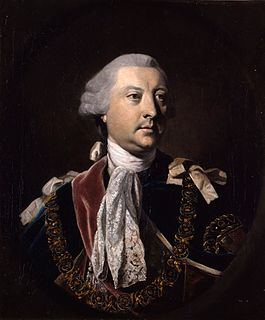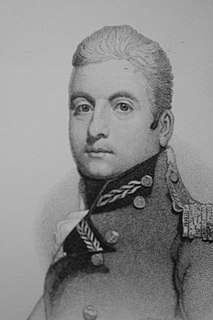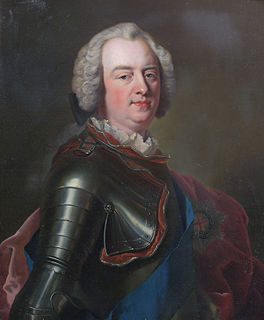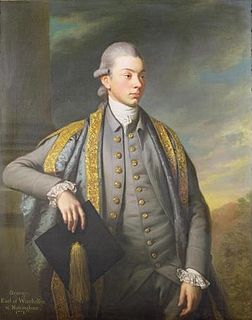 W
WJohn Russell, 4th Duke of Bedford, was an 18th-century British statesman. He was the fourth son of Wriothesley Russell, 2nd Duke of Bedford, by his wife, Elizabeth, daughter and heiress of John Howland of Streatham, Surrey. Known as Lord John Russell, he married in October 1731 Diana Spencer, daughter of Charles Spencer, 3rd Earl of Sunderland; became Duke of Bedford on his brother's death a year later; and having lost his first wife in 1735, married in April 1737 Lady Gertrude Leveson-Gower, daughter of John Leveson-Gower, 1st Earl Gower.
 W
WWilliam "Silver Billy" Beldham was an English professional cricketer who played between the 1780s and 1810s. He is generally acknowledged as one of the greatest batsmen of the sport's underarm era. In 1997, he was selected by John Woodcock of The Times as one of his 100 Greatest Cricketers of All Time.
 W
WCharles Sackville, 2nd Duke of Dorset PC, styled as Lord Buckhurst from 1711 to 1720 and the Earl of Middlesex from 1720 to 1765, was a British politician who sat in the House of Commons between 1734 and 1765. He then succeeded to the peerage as Duke of Dorset. He was also an opera impresario and cricketer.
 W
WJohn Frederick Sackville, 3rd Duke of Dorset, KG was the only son of Lord John Philip Sackville, second son of Lionel Sackville, 1st Duke of Dorset. His mother was the former Lady Frances Leveson-Gower. He succeeded to the dukedom in 1769 on the death of his uncle, Charles Sackville, 2nd Duke of Dorset. He was the British Ambassador to France from 1784 and returned to England in August 1789 following the escalation of the French Revolution.
 W
WFrederick, Prince of Wales,, was heir apparent to the British throne from 1727 until his death from a lung injury at the age of 44. He was the eldest but estranged son of King George II and Caroline of Ansbach, and the father of King George III.
 W
WGeorge Montagu-Dunk, 2nd Earl of Halifax, was a British statesman of the Georgian era. Due to his success in extending American commerce he became known as "father of the colonies". President of the Board of Trade from 1748 to 1761, he aided the foundation of Nova Scotia, 1749, the capital Halifax being named after him.
 W
WDavid Harris was an English cricketer who played first-class cricket from 1782 to 1798.
 W
WGeorge Gordon, 9th Marquess of Huntly,, styled Lord Strathavon until 1795 and known as The Earl of Aboyne from 1795 to 1836, was a Scottish peer.
 W
WSir Horatio (Horace) Mann, 2nd Baronet was a British politician who sat in the House of Commons between 1774 and 1807. He is remembered as a member of the Hambledon Club in Hampshire and a patron of Kent cricket. He was an occasional player but rarely in first-class matches.
 W
WCharles Lennox, 2nd Duke of Richmond, 2nd Duke of Lennox, 2nd Duke of Aubigny, of Goodwood House near Chichester in Sussex, was a British nobleman and politician. He was the son of Charles Lennox, 1st Duke of Richmond, 1st Duke of Lennox, the youngest of the seven illegitimate sons of King Charles II. He was the most important of the early patrons of the game of cricket and did much to help its evolution from village cricket to first-class cricket.
 W
WCharles Lennox, 4th Duke of Richmond, 4th Duke of Lennox, 4th Duke of Aubigny, was a Scottish peer, soldier, politician, and Governor General of British North America.
 W
WJohn Montagu, 4th Earl of Sandwich, PC, FRS was a British statesman who succeeded his grandfather Edward Montagu, 3rd Earl of Sandwich as the Earl of Sandwich in 1729, at the age of ten. During his life, he held various military and political offices, including Postmaster General, First Lord of the Admiralty, and Secretary of State for the Northern Department. He is also known for the claim that he was the eponymous inventor of the sandwich.
 W
WCharles Bennet, 4th Earl of Tankerville, styled Lord Ossulston from 1753 to 1767, was a British nobleman, a collector of shells and a famous patron of Surrey cricket in the 1770s. He agreed a set of cricket rules that included the first mention of the Leg before wicket rule. His wife, Emma, Lady Tankerville, was notable as a collector of exotic plants. The first tropical orchid to flower in England is named for her as it was it flowered in her greenhouse. Her collection of over 600 illustrations were purchased by Kew Gardens in 1932 and are still available today.
 W
WRichard Grenville-Temple, 2nd Earl Temple, was a British politician. He is best known for his association with his brother-in-law William Pitt who he served with in government during Britain's participation in the Seven Years War between 1756 and 1761. He resigned along with Pitt in protest at the cabinet's failure to declare war on Spain.
 W
WGeorge Finch, 9th Earl of Winchilsea, was an important figure in the history of cricket. His main contributions to the game were patronage and organisation but Winchilsea, an amateur, was also a very keen player. Finch served with the 87th Foot at the time of the American Revolutionary War from its formation in 1779 to its disbanding in 1783, with the temporary ranks of major and lieutenant-colonel.